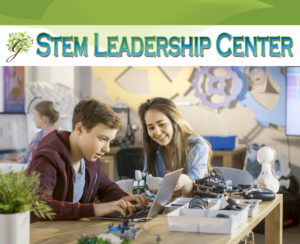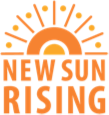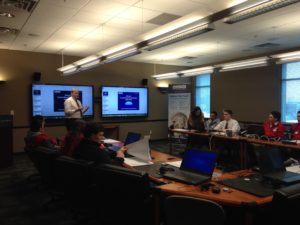 One of the most gratifying moments for a teacher is to see students engaged in purposeful wonder. David Yackuboskey and his students from the Intro to Computer Aided Design and Drafting class at Cardinal Wuerl North Catholic High School experienced a day of purposeful wonder with a STEM Careers Tour. The first stop of the STEM tour, Michael Baker International, immediately validated a curriculum that emphasizes the basics of computer aided design and drafting with 2D and 3D design software. Actual models used in the construction and renovation of our roadways were generated using the same computer software students use in the classroom. In fact, the models looked strikingly similar to the types of projects students had been completing throughout the first semester. Although the projects were more robust, drafters had to use the same skills to develop them.
One of the most gratifying moments for a teacher is to see students engaged in purposeful wonder. David Yackuboskey and his students from the Intro to Computer Aided Design and Drafting class at Cardinal Wuerl North Catholic High School experienced a day of purposeful wonder with a STEM Careers Tour. The first stop of the STEM tour, Michael Baker International, immediately validated a curriculum that emphasizes the basics of computer aided design and drafting with 2D and 3D design software. Actual models used in the construction and renovation of our roadways were generated using the same computer software students use in the classroom. In fact, the models looked strikingly similar to the types of projects students had been completing throughout the first semester. Although the projects were more robust, drafters had to use the same skills to develop them.
One of the critiques of the course from one student’s perspective, Landon Pringle – a junior at CWNCHS, is that the content can be “tedious, and kind of boring.” That same student couldn’t imagine the amount of detail oriented effort it would take to create such a model. When asked for his thoughts, Landon replied, “I don’t think I could be a transportation engineer. I mean it’s cool, but painstaking.” It means a lot to see that the skills used in the classroom are necessary in the workplace. Being able to reveal those connections is what teaching is all about, even if a particular student realizes this particular career field doesn’t fit their skill set.
Representatives showcased Michael Baker’s very own software that automates computer generated renderings of bridge cross-sections. By simply inputting a few dimensions that are specific to the project, a drafter can efficiently compile a set of drawings to be quality checked by an engineer. A second tool Michael Baker highlighted was bridge inspection training software. Students used the same software bridge inspectors are trained with to examine a virtual bridge; they navigated an environment, selected tools and analyzed structural concerns. While this not a drafting application it is a prime example of using computers to increase efficiency in the field of transportation engineering.
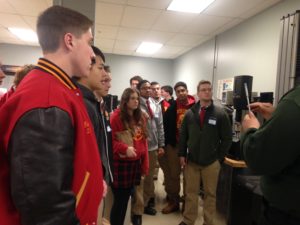 Lunchtime found the group at Robert Morris University’s Department of Engineering. The scale of RMU’s STEM efforts was exponential next to the CWNC classroom. Students were blown away by the amount of computer aided machinery available to the engineering students. Overheard from the teacher, “wait, you mean students can use all of this?”
Lunchtime found the group at Robert Morris University’s Department of Engineering. The scale of RMU’s STEM efforts was exponential next to the CWNC classroom. Students were blown away by the amount of computer aided machinery available to the engineering students. Overheard from the teacher, “wait, you mean students can use all of this?”
Students in the CWNC CADD classroom have been using software to create digital models. At RMU, students got to see how these models can be fabricated through the manufacturing process. Computer-aided manufacturing (CAM) was on full display in the department of engineering, and it peaked students’ curiosity and creativity. They wondered how a 2D drawing could be used to guide the arm of a robotic router and etch a precise name into a plastic block. They also mused about the countless other applications of this technology.
STEM Career Tours are not only meant to inspire students. It is hoped that the instructor, as well, finds inspiration and new insights. David Yackuboskey said of his visit to Robert Morris, “Seeing this inspired me to push the curriculum further in future iterations of this course. It is my goal to provide opportunities for students to fabricate their own drawings and complete the CADD-CAM loop.”
RMU provided all the participants with flashy highlights of the laser scanner that can generate a 3D CADD model but also a deeper realization. Students recognized that the seemingly simple skills they are developing in class are being honed at universities across the nation and deployed to solve some of our generation’s most pressing challenges.
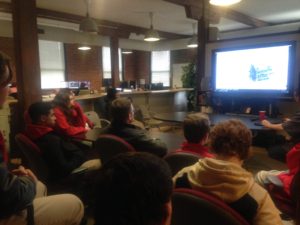 The afternoon brought the STEM athletes to Cadnetics, a full service production team that leads a project from existing building document, through computer aided design and building information modeling, to 3D visual representations. James Mauler and Travis Johnson, the president and vice president of Cadnetics, captured students’ attention with a laser scanner render a three-dimensional model of the room they were in. The model was created and could then be manipulated using similar CADD software to what we use in the classroom.
The afternoon brought the STEM athletes to Cadnetics, a full service production team that leads a project from existing building document, through computer aided design and building information modeling, to 3D visual representations. James Mauler and Travis Johnson, the president and vice president of Cadnetics, captured students’ attention with a laser scanner render a three-dimensional model of the room they were in. The model was created and could then be manipulated using similar CADD software to what we use in the classroom.
The common connection of Cadnetics and the students’ curriculum was communication through visualization of a project. Whether through technical drawings or illustrative renderings, Cadnetics can put a computer to work with purpose. Students were struck by the fact that this local company is having a national and even global impact through their knowledge of CAD.
One of the most interesting lessons students gleaned during the STEM Careers Tour was that the company covets students with short term, 1-2 year, technical degrees. Cadnetics values employees with very specific skill sets. James commented that jack-of-all-trade graduates with 4-year degrees often lack the ability to produce results efficiently.
This STEM Career Tour echoed what is repeated again and again by the business communities we visit. Industries are being exponentially transformed by digital technology. Traditional “blueprints” are outdated thanks to the impact CADD has had in the industries of architecture and construction management. This experience, in combination with a passionate teacher who wants to apply what they’ve learned in future offerings in the classroom, and project based opportunities for the students, prepares a new generation for the 21st century jobs we can only imagine.
Read more at www.stemcareertours.com

